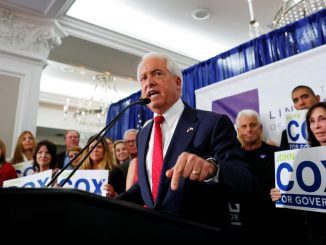
Amid news that Donald Trump is about to be indicted by a hyperpartisan prosecutor and of his hysterical responses, and prompted by vagrant reading about the War of 1812 and Woodrow Wilson’s violations of civil liberties in World War I, a thought occurred to me.
America seems to go crazy every 50 years or so.
Start with the War of 1812, about 50 years after colonies’ Stamp Act protests. There’s a touch of absurdity here. Because of the slowness of trans-Atlantic communication, Congress declared war because of British restrictions on neutral shipping six days after the British repealed them. Americans won their major land victory in New Orleans, 15 days after the peace treaty had already been signed in Ghent.
The Americans’ strategy was based on a delusion — that Canadians would welcome American conquest — and American tactics were riddled with blunders. Detroit was surrendered without a shot, and Washington was left undefended, allowing the British to burn the White House. The treaty left in place the status quo, and the positive response was psychological, verging on delusional. In historian Gordon Wood’s words, this inconclusive war “did finally establish for Americans that independence and nationhood of the United States that so many had doubted.”
Almost exactly 50 years later, the U.S. plunged into civil war, which outgoing President James Buchanan might have prevented by sending troops to secessionist South Carolina as his mentor Andrew Jackson had done almost 30 years earlier. But the differences were fundamental. Democrats supported the “liberty” of slaveholders to retain their “property” anywhere in a nation where an increasing number of citizens regarded slavery as intolerable. Republicans were determined to deploy the federal government to put slavery, in Abraham Lincoln’s words, “on the path to extinction.”
Winfield Scott, a young officer in 1812, provided Lincoln with the Anaconda strategy, squeezing the South by blockade until Grant and Sherman could defeat the Confederate armies. The result wasn’t crazy — slavery was abolished in an ultimately intact Union. But it all came at a crazy cost, with some 600,000 lives in a nation of 38 million lost.
Fast forward 50 years to the only American president who spent his boyhood in the Confederacy, watching Sherman march into South Carolina, Woodrow Wilson. After Congress, with 56 dissenters, voted to enter World War I, Wilson superintended the overbroad 1917 Espionage Act. As Adam Hochschild vividly recounts in “American Midnight,” the Wilson administration imprisoned those who spoke against the war or the draft, including Socialist presidential candidate Eugene Debs. Wilson deported aliens supposedly involved in radical activities under the supervision of the 20-something J. Edgar Hoover. He censored the press, stamping out what liberals today call “misinformation,” and cooperated with local efforts to suppress German cultural organizations.
As Hochschild makes clear, it wasn’t only the Wilson administration that went crazy. Radical anarchists set off deadly bombs on Wall Street, at Attorney General A. Mitchell Palmer’s house and across the street from Assistant Navy Secretary Franklin Roosevelt.
The much-derided “Red Scare” was a response to fears raised by the takeover of the larger and more populous Russia by a handful of Bolsheviks, whose murderous and squalid regime ended up lasting 70 years. Americans a century ago didn’t know that this wasn’t going to happen here.
Sometimes people can learn from mistakes. In World War II, FDR, who witnessed Wilson’s excesses up close, didn’t seize the railroads or shipyards. With the important exception of the Japanese American internments, he also didn’t violate civil liberties as Wilson had.
Unfortunately, sometimes people don’t learn. Fifty years ago, America saw a tripling, roughly, of violent crime and welfare dependency in a decade, even as prison populations were reduced and police delegitimized. A rash of hundreds of violent bombings was followed by serious government misconduct.
Ironically, after the 1964-68 Civil Rights acts changed America for the better, there were cries that racist treatment of blacks was as bad as ever. America was going crazy again, on schedule.
And so it has in the last few years. After the election and reelection of the first black president, we heard Black Lives Matter, like the Black Panthers 50 years before, proclaim that America was even more racist than it ever had been. Since the “mostly peaceful” riots of summer 2020, there have been sharp increases in violent crime and moves to defund and delegitimize police departments which are, in fact, far less racist than in the 1960s.
America went crazy too over COVID, in my view, by treating a virus fatal to just a small segment of the population as if, like Ebola, it had an infection fatality rate of around 50%. Authorities imposed lockdowns and mandates while ignoring economic costs and lasting collateral damage, like adults missing cancer screenings and children missing first and second grade.
Like Woodrow Wilson’s propagandist George Creel, government agencies suppressed as “misinformation” speech and arguments, including many that turned out to be accurate.
Another symptom of America going crazy is presidential dysfunction. Fifty years ago, the highly intelligent and experienced Lyndon Johnson and Richard Nixon were ousted at ages 60 and 61 because of Vietnam and Watergate. Now, despite repeated stumbles, the inexperienced and distractable Donald Trump and the (according to bipartisan Defense Secretary Robert Gates) nearly-always-wrong Joe Biden are seeking second terms they would complete at ages 82 and 86, respectively.
Having witnessed and written for publication during two 50-years-apart episodes of craziness, I seek consolation from Adam Smith’s reflection, after Britain lost the 13 colonies, that “there is a great deal of ruin in a nation.” But I hope America will do a better job, 50 years hence, of learning from this episode’s mistakes.
Michael Barone is a senior political analyst for the Washington Examiner, resident fellow at the American Enterprise Institute and longtime co-author of “The Almanac of American Politics.”



